Ames W.F., Harrel E.M., Herod J.V. (editors). Differential Equations with Applications to Mathematical Physics
Подождите немного. Документ загружается.

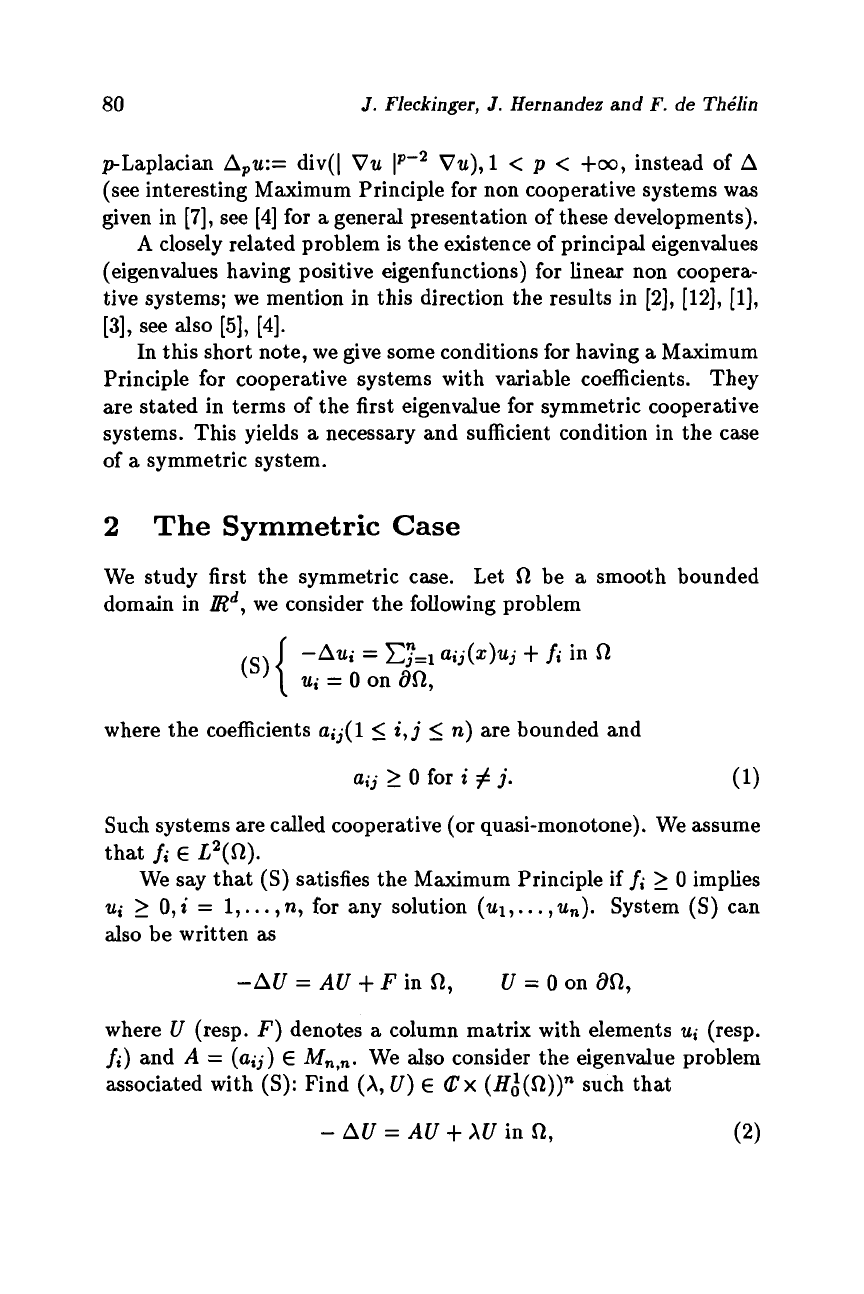
80
J.
Fleckinger,
J.
Hernandez and F. de Thdin
pLaplacian
Apu:=
div(1
Vu
lPe2
VU),~
<
p
<
+m,
instead of
A
(see interesting Maximum Principle for non cooperative systems was
given in
[7],
see
[4]
for
a
general presentation of these developments).
A
closely related problem is the existence of principal eigenvalues
(eigenvalues having positive eigenfunctions) for linear non coopera-
tive systems; we mention in this direction the results in
[2], [12],
[l],
[3],
see also
[5],
[4].
In this short note, we give some conditions for having
a
Maximum
Principle for cooperative systems with variable coefficients. They
are stated in terms of the first eigenvalue for symmetric cooperative
systems. This yields
a
necessary and sufficient condition in the case
of
a
symmetric system.
2
The
Symmetric
Case
We study first the symmetric case. Let
R
be
a
smooth bounded
domain in
Rd,
we consider the following problem
-Aui
=
cy=l
aij(2)uj
+
fi
in
R
ui
=
0
on
aR,
where the coefficients
aij(1
5
i,
j
5
n)
are bounded and
Such
systems are called cooperative
(or
quasi-monotone). We assume
that
f;
E
L2(R).
We say that
(S)
satisfies the Maximum Principle iff;
2
0
implies
u;
2
0,i
=
I,.
. .
,n,
for
any solution
(211,.
. .
,un).
System
(S)
can
also
be written
as
-AU
=
AU
+
F
in
R,
U
=
0
on
aR,
where
U
(resp.
F)
denotes
a
column matrix with elements
ui
(resp.
fi)
and
A
=
(aij)
E
We also consider the eigenvalue problem
associated with
(S):
Find
(A,
U)
E
ex
(H;(R))"
such that
-
AU
=
AU
+
XU
in
0,
(2)
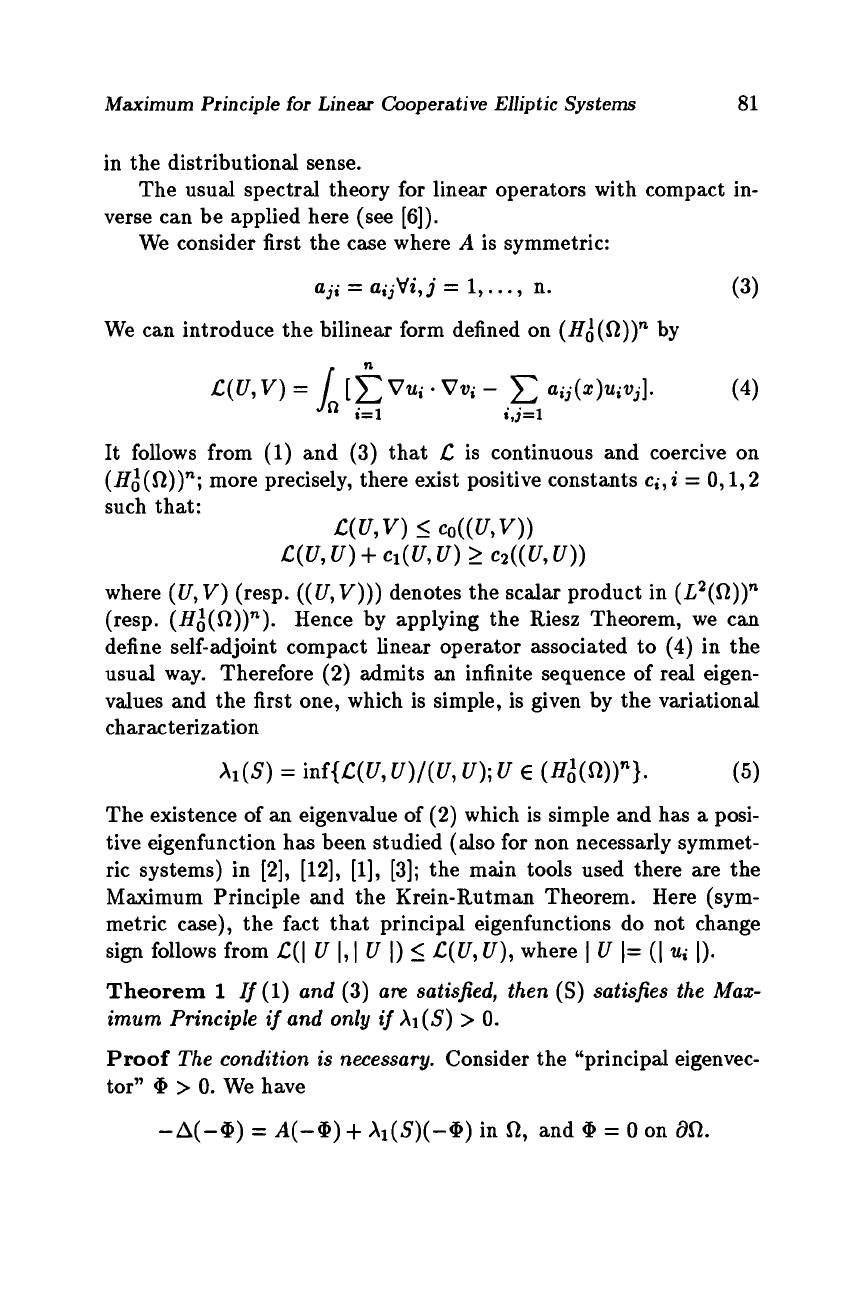
Maximum Principle
for
Linear Cooperative Elliptic Systems
81
in the distributional sense.
verse can be applied here (see
[6]).
The usual spectral theory for linear operators with compact in-
We consider first the case where
A
is symmetric:
a,;
=
ajjQi,
j
=
1,.
. .
,
n.
(3)
We can introduce the bilinear form defined on
(Hi(Q))n
by
It follows from
(1)
and
(3)
that
L
is continuous and coercive on
(Ho(Q))n;
more precisely, there exist positive constants
c;,i
=
0,1,2
such that:
L(K
V)
I
CO((U,
V))
L(U,
U)
+
Cl(U,
U)
1
C2((U,
U))
where
(U,
V)
(resp.
((U,
V)))
denotes the scalar product in
(L2(Q)).
(resp.
(Hi(fl))n).
Hence by applying the Riesz Theorem, we can
define self-adjoint compact linear operator associated to
(4)
in the
usual way. Therefore
(2)
admits an infinite sequence of real eigen-
values and the first one, which is simple, is given by the variational
characterization
x~(s)
=
inf{L(U,
u)/(u,
u);
u
E
(~o(S2))~).
(5)
The existence of an eigenvalue of
(2)
which is simple and has
a
posi-
tive eigenfunction has been studied (also for non necessarly symmet-
ric systems) in
[2], [12], [l], [3];
the main tools used there are the
Maximum Principle and the Krein-Rutman Theorem. Here (sym-
metric case), the fact that principal eigenfunctions do not change
sign follows from
L(l
U
1,
I
U
I)
5
L(U,
U),
where
I
U
I= (I
uj
I).
Theorem
1
If
(1)
and
(3)
are satisfied, then
(S)
satisfies the Max-
imum Principle if and only
if
&(S)
>
0.
Proof
The condition is necessary.
Consider the “principal eigenvec-
tor”
@
>
0.
We have
-A(-@)
=
A(-@)
+
Xl(S)(-@)
in
Q,
and
9
=
0
on
80.

82
J.
Fleckinger,
J.
Hernandez and F. de The'lin
When
XI(S)
5
O,Xl(S)(-@)
2
0
and
(S)
does not satisfy the
Maxi-
mum Principle.
The condition is sufficient. Multiplying
(S)
by ui
=
mu(-ui,O)
we get
n
J,
vU~
*
VUY
=
/
c
aij(x)ujur
+
J,
fi.T.
'
j=1
Hence using classical results by Stampacchia
By adding these inequalities,
.C(U-,
U-)
5
0,
so
that, by
(5),
X,(s).(u-,u-)
5
0.
Since by hypothesis,
X1(S)
>
0,
we obtain
(U-, U-)
=
0
and hence
It is very easy
to
check that the condition given in Theorem
1
coincides with the one in
[8]
in the constant coefficient case and
n
=
2.
If
one looks for positive solutions of
-Au
=
au
+
bv
+
6u in
0
-Av=bu+dv+6vinR
(6)
I
u=v=O
onaR
of the form
(acpl,Pcpl),
where (Xl(-A),cpl) is the principal eigenpair
associated with the Dirichlet Laplacian on
0,
one obtains the linear
system
[X,(-A)
-
X
-
U]CY
-
bp
=
0
-ba
+
[X,(-A)
-
X
-
d]p
=
0;
the first eigenvalue
A,
of
(6)
which ensures that
CY
>
0,p
>
0
is given
bv
Now,
it is easy to see that
A,
>
0
if and only if
[Xl(-A)
-
u][X,(-A)
-
d]
>
b2,
which is the condition obtained in [8],
[9].
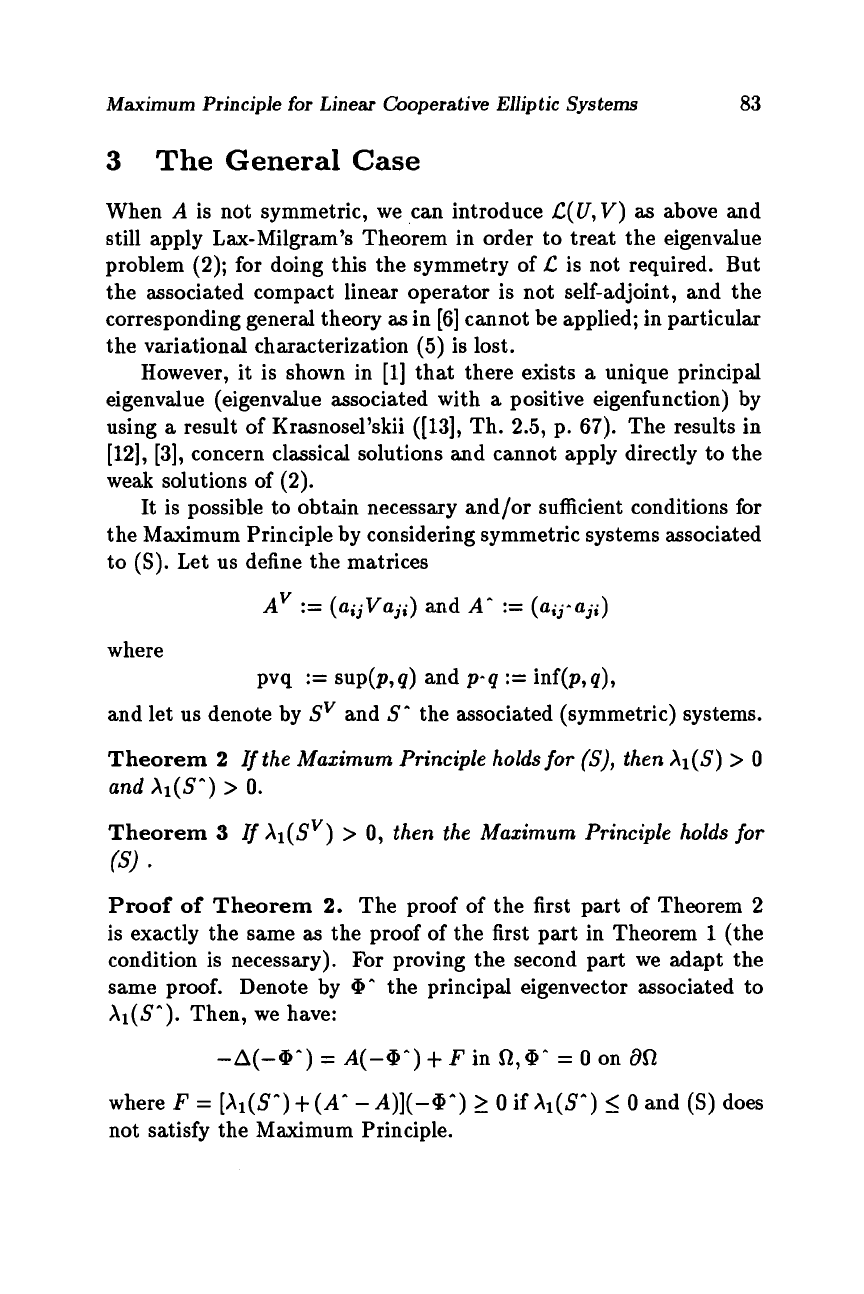
Maximum Principle
for
Linear Cooperative Elliptic
Systems
83
3
The General Case
When
A
is not symmetric, we can introduce
L(
U,
V)
as
above and
still apply Lax-Milgram's Theorem in order to treat the eigenvalue
problem
(2);
for doing this the symmetry of
L
is not required. But
the associated compact linear operator is not self-adjoint, and the
corresponding general theory
as
in
[6]
cannot be applied; in particular
the variational characterization
(5)
is lost.
However, it is shown in
[l]
that there exists
a
unique principal
eigenvalue (eigenvalue associated with
a
positive eigenfunction) by
using
a
result of Krasnosel'skii
([13],
Th.
2.5,
p.
67).
The results in
[12], [3],
concern classical solutions and cannot apply directly to the
weak solutions of
(2).
It
is possible to obtain necessary and/or sufficient conditions for
the Maximum Principle by considering symmetric systems associated
to
(S).
Let us define the matrices
AV
:=
(ajjV~j;)
and
A"
:=
(ajj-aji)
where
pvq
:=
sup(p,q) and p-q
:=
inf(p,q),
and let us denote by
Sv
and
S"
the associated (symmetric) systems.
Theorem
2
If
the Maximum Principle holds
for
(S),
then
X1(S)
>
0
and
X1(S^)
>
0.
Theorem
3
If
X1(Sv)
>
0, then the
Maximum
Principle holds
for
(S)
*
Proof
of
Theorem
2.
The proof of the first part of Theorem
2
is exactly the same
as
the proof of the first part in Theorem
1
(the
condition is necessary).
For
proving the second part we adapt the
same proof. Denote by
@*
the principal eigenvector associated to
X1(SA).
Then, we have:
-A(-@-)
=
A(-$^)
+
F
in
0,9*
=
0 on
80
where
F
=
[X1(S*)+(A^
-
A)](-@^)
2
0
if
Xl(S^)
5
0
and
(S)
does
not satisfy the Maximum Principle.
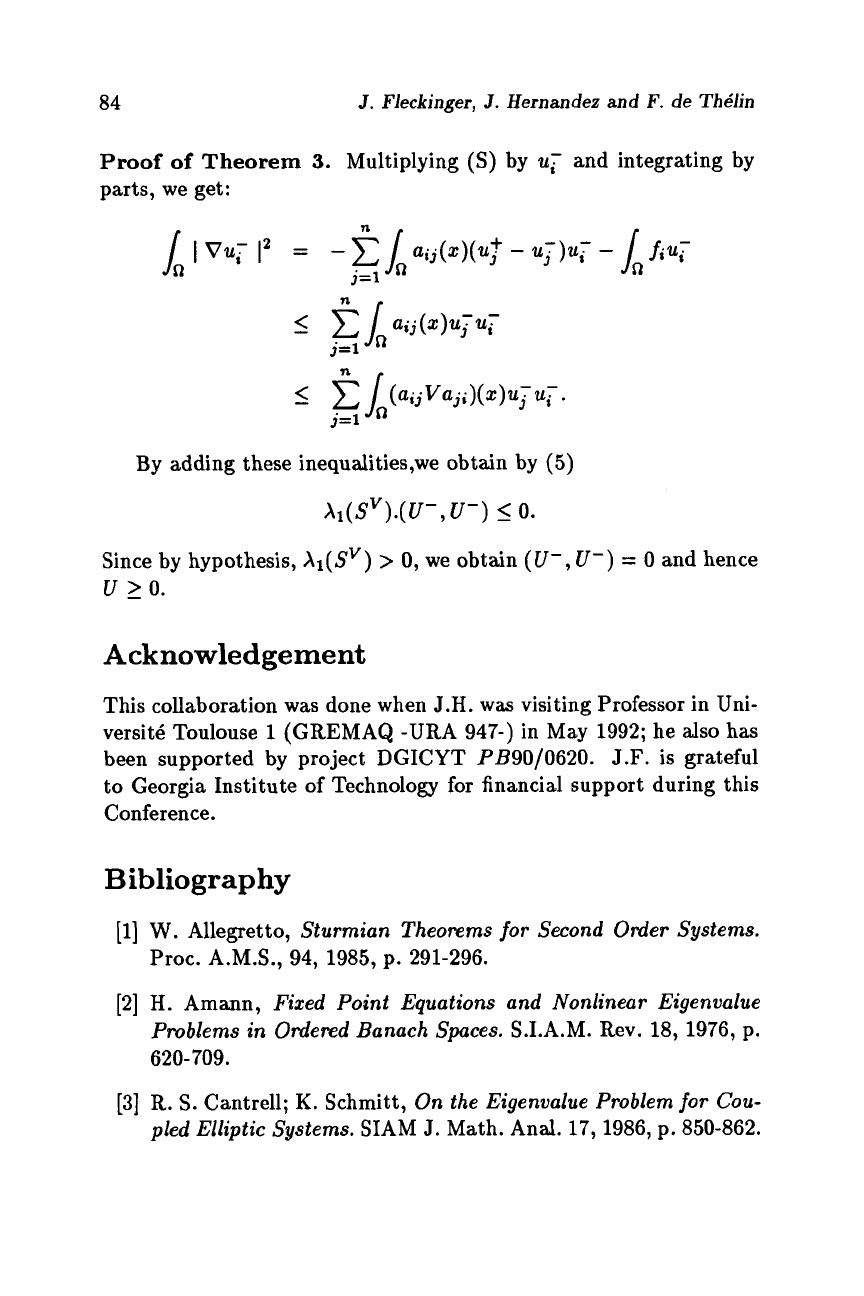
84
J.
Fleckinger,
J.
Hernandez and
F.
de Thdin
Proof
of
Theorem
3.
Multiplying
(S)
by
uf
and integrating by
parts, we get:
n
J,
j=1
n.
By adding these inequalities,we obtain by
(5)
x,(sV).(u-,
u-)
5
0.
Since by hypothesis,
X,(Sv)
>
0,
we obtain
(17-,
U-)
=
0
and hence
u
2
0.
Acknowledgement
This collaboration was done when J.H.
was
visiting Professor in Uni-
versit6 Toulouse
1
(GREMAQ -URA
947-)
in May
1992;
he also has
been supported by project DGICYT
PB90/0620.
J.F.
is grateful
to Georgia Institute of TechnologV for financial support during this
Conference.
Bibliography
[l]
W.
Allegretto,
Sturmian Theorems for Second Order Systems.
Proc. A.M.S.,
94, 1985,
p.
291-296.
[2]
H. Amann,
Fixed Point Equations and Nonlinear Eigenvalue
Problems in Ordered Banach Spaces.
S.I.A.M. Rev.
18, 1976,
p.
620-709.
[3]
R.
S.
Cantrell;
K.
Schmitt,
On the Eigenvalue Problem
for
Cou-
pled Elliptic Systems.
SIAM
J.
Math. Anal.
17, 1986,
p.
850-862.

Maximum Principle
for
Linear Cooperative Elliptic Systems
85
[4]
C. Cosner;
J.
Hernhdez; E. Mitidieri,
Mazimum Principles
and Applications to Reaction-Diflusion Systems.
Birkhauser;
Boston; (in preparation).
[5]
C. Cosner,
Eigenvalue Problems
with
Indefinite Weights and Re-
action Diflusion Models in Population Dynamics.
In
Reaction-
Diflusion Equations,
K.
J.
Brown and A. A. Lacey (eds), Oxford
SC. Publ.,
1990,
p.
117-137.
[6]
R. Courant; D. Hilbert,
Methods
of
Mathematical Physics
Inter-
science, New York,
1953
[7]
D.
G.
de Figueiredo;
E.
Mitidieri,
A Mazimum Principle
for
an Elliptic System and Applications to Sernilinear Problems.
S.I.A.M.
J.
Math. Anal.,
17, 1986,
p.
836-849.
[8]
D. G. de Figueiredo; E. Mitidieri,
Mazimum Principles for
Co-
operative Elliptic Systems,
Comptes Rendus Acad. Sc. Paris,
310, 1990,
p.
49-52
[9]
D. G. de Figueiredo;
E.
Mitidieri,
Mazirnum Principles for Lin-
ear Elliptic Systems,
(to appear)
[lo]
J.
Fleckinger;
J.
Hernandez;
F.
de Thdlin,
Principe
du
mazirnurn
pour un systdme elliptique non liniaire
Comptes Rendus Acad.
Sc. Paris,
t.314,
Ser.
I,
p.
665-668, 1992.
[ll]
J.
Fleckinger;
J.
Hernandez;
F.
de Thdlin,
On Mazimum Prin-
ciples and Existence
of
Positive Solutions for some Cooperative
Elliptic Systems,
(submitted to Differential and Integral Equa-
tions).
[12]
P.
Hess,
On the Eigenvalue Problem
for
Weakly Coupled Elliptic
Systems,
Arch. Rat. Mech. Anal.,
81, 1983,
p.
151-159.
[13]
M. A. Krasnosel’skii,
Positive Solutions
of
Operator Equations
Nordhoff, Grooningen,
1964
[14]
M. H. Protter; H. Weinberger,
Mazimurn Principles in Difler-
ential Equations,
Prentice Hall, Englewood Cliffs,
1967.
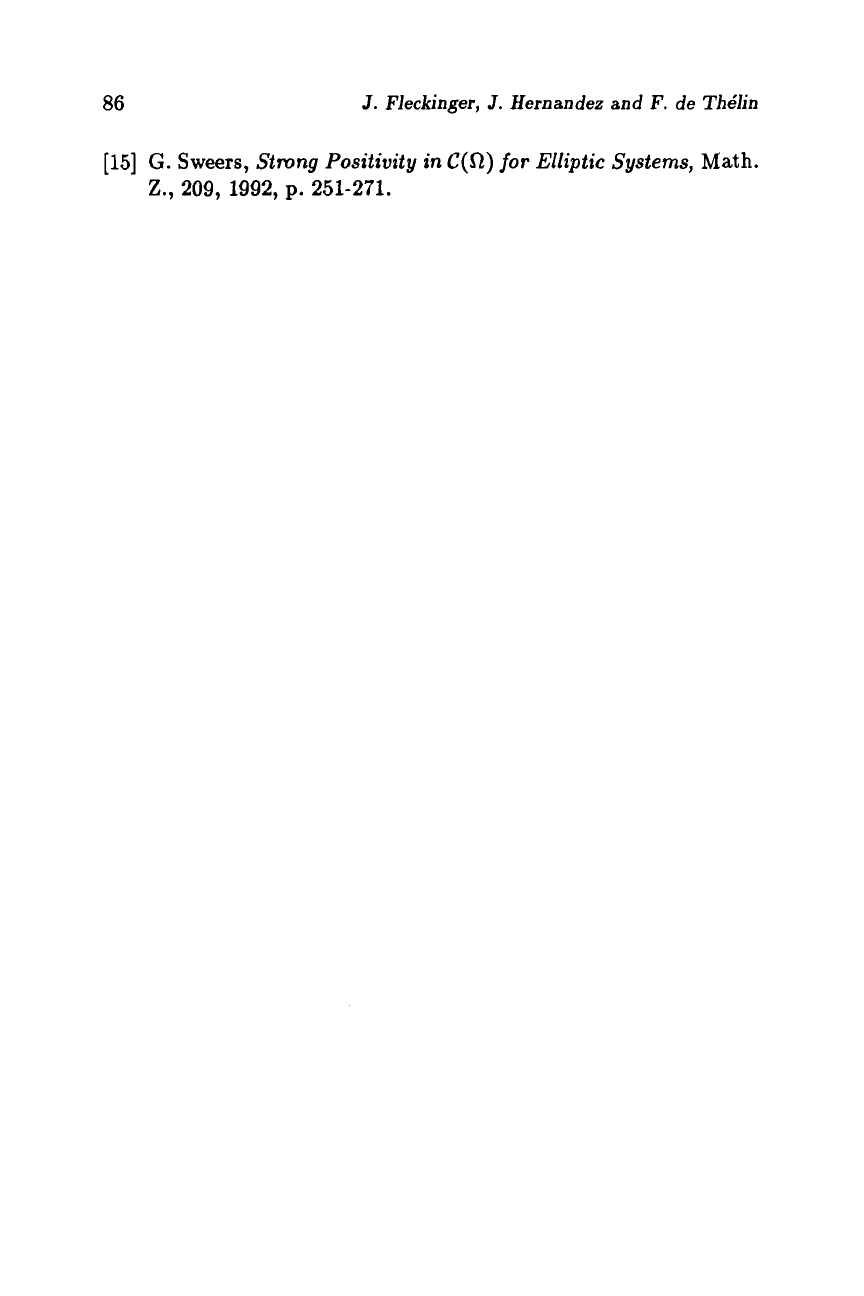
86
J.
Fleckinger,
J.
Hernandez and F. de Thdin
[15]
G.
Sweers,
Strong Positivity in
C(R)
for
Elliptic Systems,
Math.
Z.,
209, 1992,
p.
251-271.
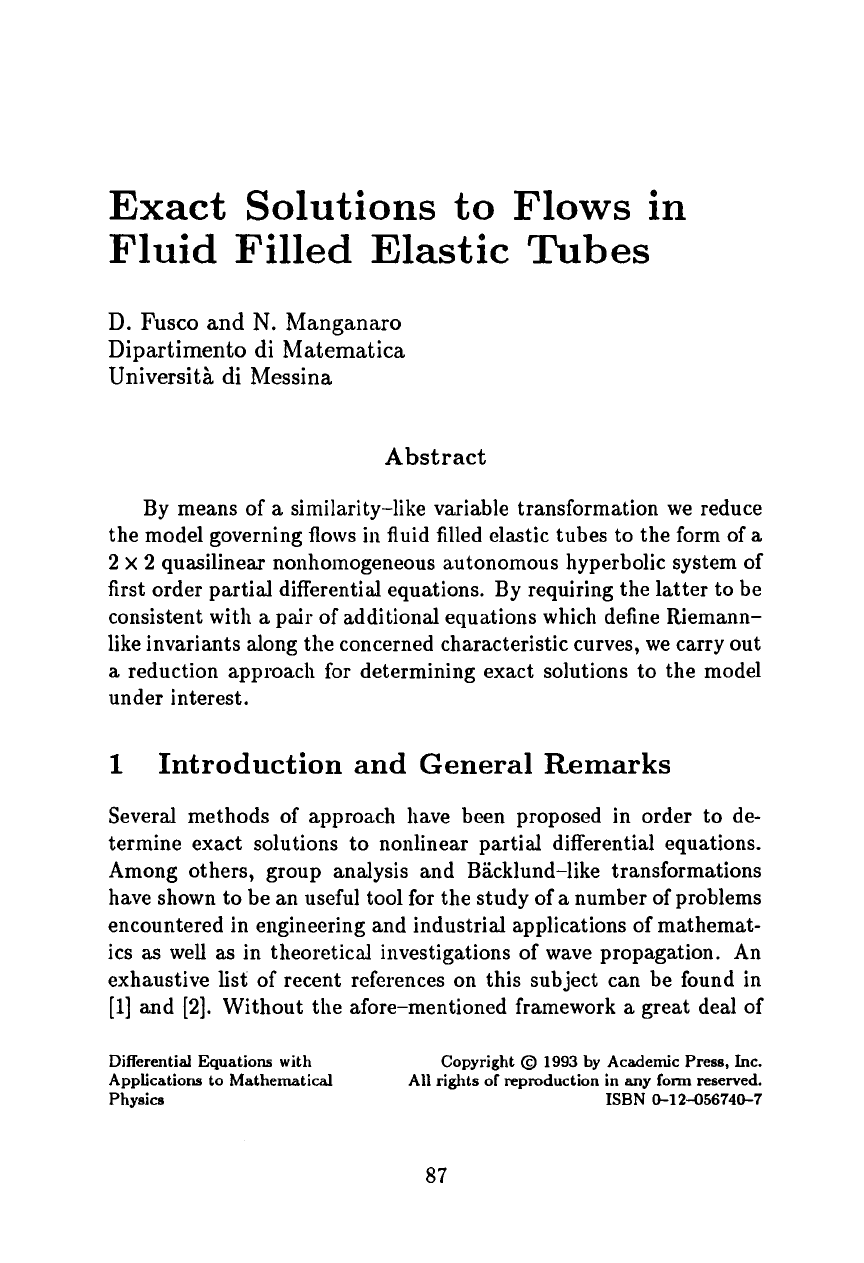
Exact Solutions to Flows
in
Fluid Filled Elastic Tubes
D.
Fusco
and
N.
Manganaro
Dipartimento
di
Matematica
Universiti
di
Messina
Abstract
By means of
a
similarity-like variable transformation we reduce
the model governing
flows
in fluid filled elastic tubes to the form of
a
2
x
2
quasilinear nonhomogeneous autonomous hyperbolic system of
first order partial differential equations. By requiring the latter to be
consistent with
a
pair
of
additional equations which define Riemann-
like invariants along the concerned characteristic curves, we carry out
a
reduction approach
for
determining exact solutions to the model
under interest.
1
Introduction and General Remarks
Several methods of approach have been proposed in order to de-
termine exact solutions to nonlinear partial differential equations.
Among others, group analysis and Backlund-like transformations
have shown to be an useful tool for the study of
a
number of problems
encountered in engineering and industrial applications of mathemat-
ics
as
well
as
in theoretical investigations of wave propagation. An
exhaustive list of recent references on this subject can be found in
[l]
and
[2].
Without the afore-mentioned framework
a
great deal of
Differential Equations with Copyright
@
1993
by Academic Press, Inc.
Applications
to
Mathematical All rights
of
reproduction
in
any
form
reserved.
Physics
ISBN
0-1
2-056740-7
87
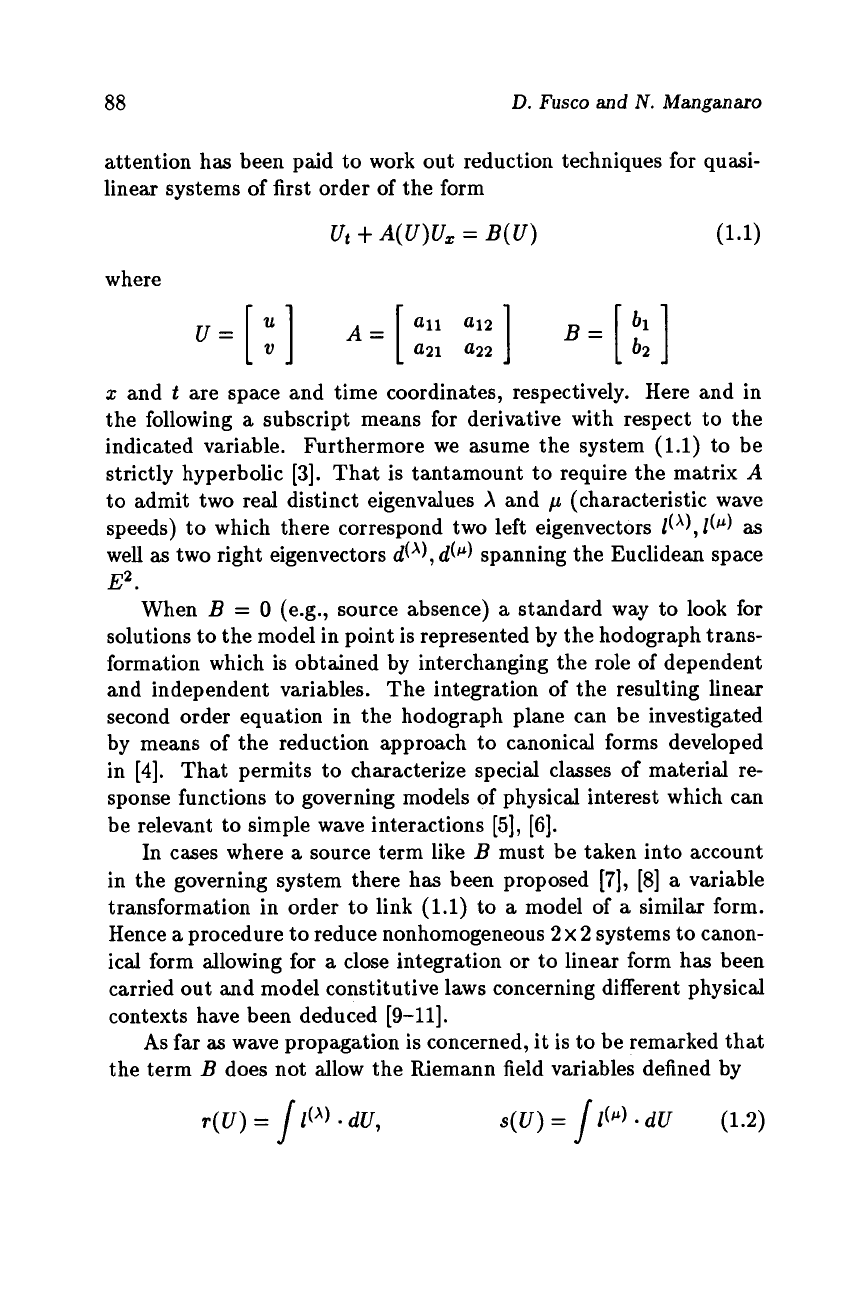
88
D.
Fusco
and
N.
Manganaro
attention has been paid to work out reduction techniques for quasi-
linear systems of first order of the form
where
U=
[
:]
A=[
:::
B=[
z
and
t
are space and time coordinates, respectively. Here and in
the following
a
subscript means for derivative with respect to the
indicated variable. Furthermore we asume the system
(1.1)
to be
strictly hyperbolic
[3].
That is tantamount to require the matrix
A
to admit two real distinct eigenvalues
X
and
p
(characteristic wave
speeds) to which there correspond two left eigenvectors
Z(A),Z(@)
as
well as two right eigenvectors
d(’),
d(@)
spanning the Euclidean space
E2.
When
B
=
0
(e.g., source absence)
a
standard way to look for
solutions to the model in point is represented by the hodograph trans-
formation which is obtained by interchanging the role of dependent
and independent variables. The integration of the resulting linear
second order equation in the hodograph plane can be investigated
by means
of
the reduction approach to canonical forms developed
in
[4].
That permits to characterize special classes of material
re-
sponse functions to governing models
of
physical interest which can
be relevant to simple wave interactions
[5],
[6].
In cases where
a
source term like
B
must be taken into account
in the governing system there has been proposed [7],
[8]
a
variable
transformation in order to link (1.1) to
a
model of
a
similar form.
Hence
a
procedure to reduce nonhomogeneous 2 x 2 systems to canon-
ical form allowing for
a
close integration
or
to linear form has been
carried out and model constitutive laws concerning different physical
contexts have been deduced [9-111.
As
far
as
wave propagation is concerned, it is to be remarked that
the term
B
does not allow the Ftiemann field variables defined by
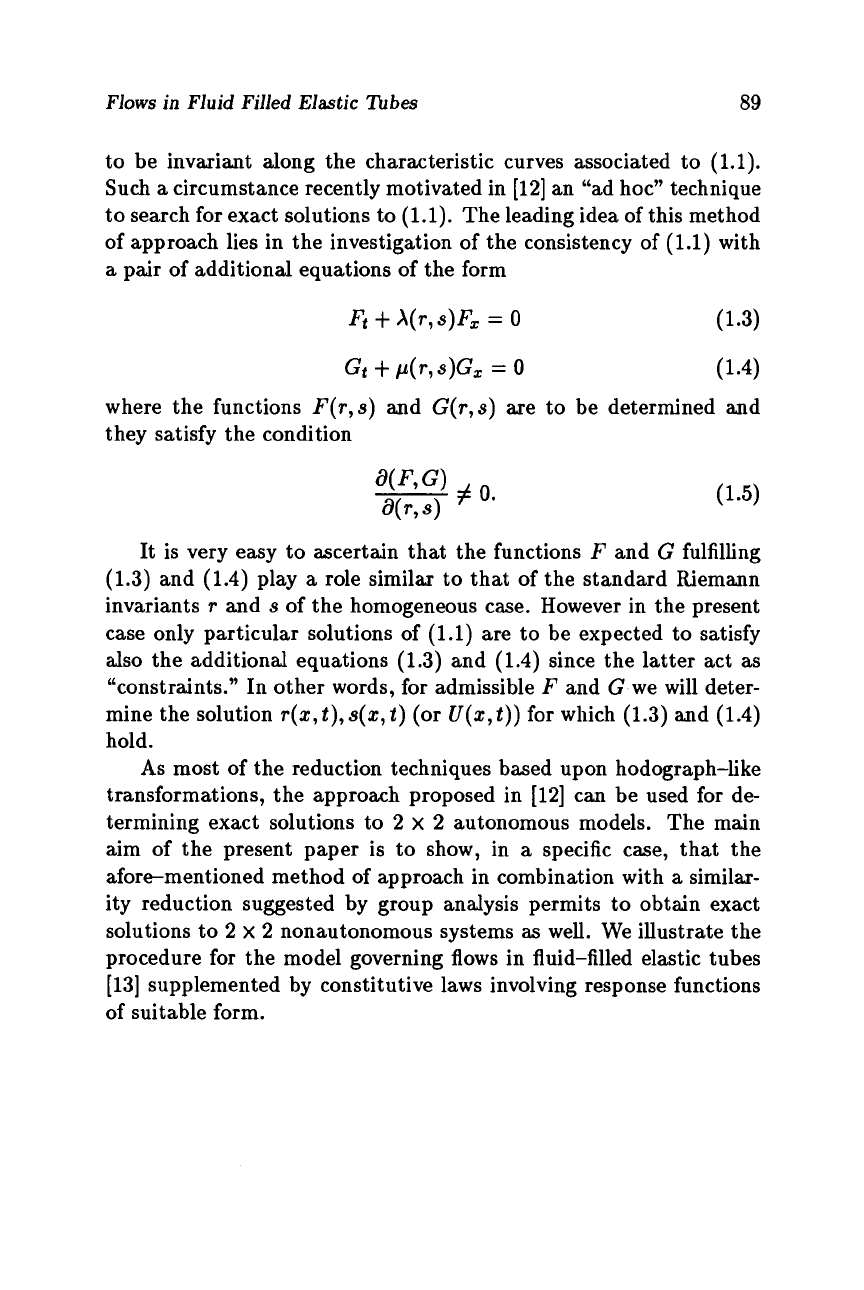
Flows in Fluid Filled Elastic nbes
89
to be invariant along the characteristic curves associated to
(1.1).
Such
a
circumstance recently motivated in
[12]
an “ad hoc” technique
to search for exact solutions to
(1.1).
The leading idea of this method
of approach lies in the investigation of the consistency of
(1.1)
with
a
pair of additional equations of the form
Ft
4-
X(T,S)F,
=
0
Gt
+
P(T,
s)G,
=
0
(1.4)
where the functions
F(T,s)
and
G(T,s)
are to be determined and
they satisfy the condition
It is very easy to ascertain that the functions
F
and
G
fulfilling
(1.3)
and
(1.4)
play
a
role similar to that of the standard Riemann
invariants
T
and
s
of the homogeneous case. However in the present
case only particular solutions of
(1.1)
are to be expected to satisfy
also
the additional equations
(1.3)
and
(1.4)
since the latter act as
“constraints.” In other words, for admissible
F
and
G
we will deter-
mine the solution
r(z,t),s(z,t)
(or
U(z,t))
for which
(1.3)
and
(1.4)
hold.
As
most of the reduction techniques based upon hodograph-like
transformations, the approach proposed in
[12]
can be used for de-
termining exact solutions to
2
x
2
autonomous models. The main
aim of the present paper is to show, in
a
specific case, that the
aforementioned method of approach in combination with
a
similar-
ity reduction suggested by group analysis permits to obtain exact
solutions to
2
x
2
nonautonomous systems
as
well. We illustrate the
procedure for the model governing flows in fluid-filled elastic tubes
[13]
supplemented by constitutive laws involving response functions
of suitable form.
